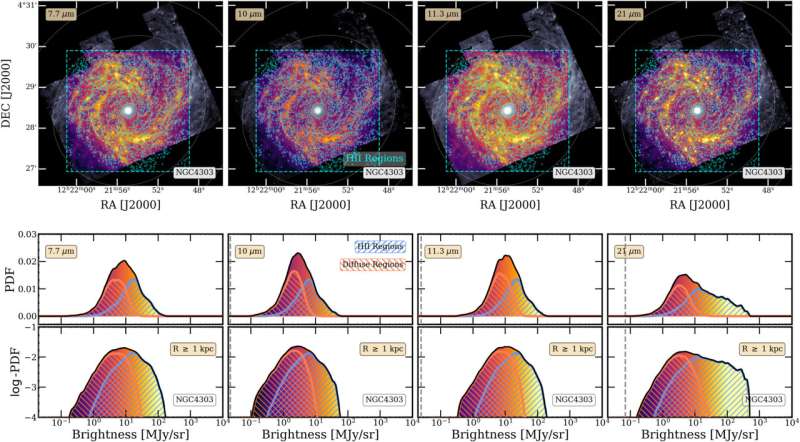This article has been reviewed according to Science X's editorial process and policies. Editors have highlighted the following attributes while ensuring the content's credibility:
fact-checked
peer-reviewed publication
trusted source
proofread
Study delivers detailed photos of galaxies' inner structures

For the first time, high-resolution images captured by the James Webb Space Telescope are offering powerful insights into the complex dust patterns of nearby star-forming galaxies.
One of the most fundamental building blocks in the universe, cosmic dust is a vital ingredient to the growth of a galaxy. When scattered, these tiny grains help plant the seeds for the creation of stars and planets alike—yet only recently, through rapid leaps in technology, have astronomers begun to shine a brighter light on their intricate physics.
Led by scientists at The Ohio State University, an international team of astronomers used data collected by the James Webb Space Telescope's Mid-Infrared Instrument to create stunning visuals of 19 spiral galaxies located relatively close to the Milky Way. By examining infrared light—wavelengths invisible to the naked eye—these incredibly precise images reveal how dust fertilizes the universe after being heated by both massive young stars and surrounding interstellar space radiation.
"Using this brand new data, we're able to see the distribution of dust emission and determine what the interstellar material in the disks of these galaxies looks like," said Debosmita Pathak, lead author of the study and a graduate student in astronomy at Ohio State.
The images were taken from the PHANGS-JWST Cycle 1 Treasury, a survey collaboration that uses high-powered telescopes to better understand galactic evolution. In this study, they used data collected from the first year of Webb observations to create probability distribution function (PDF) measurements that chart the galaxies' dust emissions in the mid-infrared.
They found that the disks of galaxies in the mid-infrared show both a normal distribution of gas (represented in the study's PDF charts as a high peak) and a high distribution (appearing as a gentle slope). While the regions where star-forming nurseries reside look noticeably different, the shape and width of the distribution of diffuse gas in these galaxies stayed consistent.
"Dynamically, they've all got very different things going on in the centers," said Pathak. "But once you take the centers out of the picture, the disks of these galaxies look very similar to each other."
The study, published recently in The Astronomical Journal, suggests that because the patterns of infrared light emitted by these observed galaxies seem to be uniform, the density of the gas inside galactic disks follows a specific pattern even when shaped by very different galactic environments.
"Because this dust traces out the fuel for future generations of stars," Pathak said, "the similarity we see among galaxies hints that some aspects of star and planet formation may be universal across galaxies."
By illuminating another clue about the mysteries of our universe, these galactic snapshots also provide an opportunity for humans to take a look in the cosmic mirror, Pathak said.
"It's hard for us to get a global perspective of the Milky Way," said Pathak. "This study tells us that if you looked at it as an outsider, you would see something similar to what we saw for a bunch of other nearby galaxies."
Moreover, deepening our current understanding of the structure of nearby galaxies could lead to a better grasp of astrophysics, including how various objects in the universe fit together.
Ultimately, once more data becomes available after the next few JWST cycles, the team plans to redo much of the work with an even larger and richer sample size.
"You can't observe all galaxies in the universe at such high resolutions, so it helps to be able to make quantitative statements about them in general, because that allows us to extrapolate about more and more galaxies in the future," said Pathak.
More information: Debosmita Pathak et al, A Two-Component Probability Distribution Function Describes the Mid-IR Emission from the Disks of Star-forming Galaxies, The Astronomical Journal (2023). DOI: 10.3847/1538-3881/ad110d
Journal information: Astronomical Journal
Provided by The Ohio State University




















